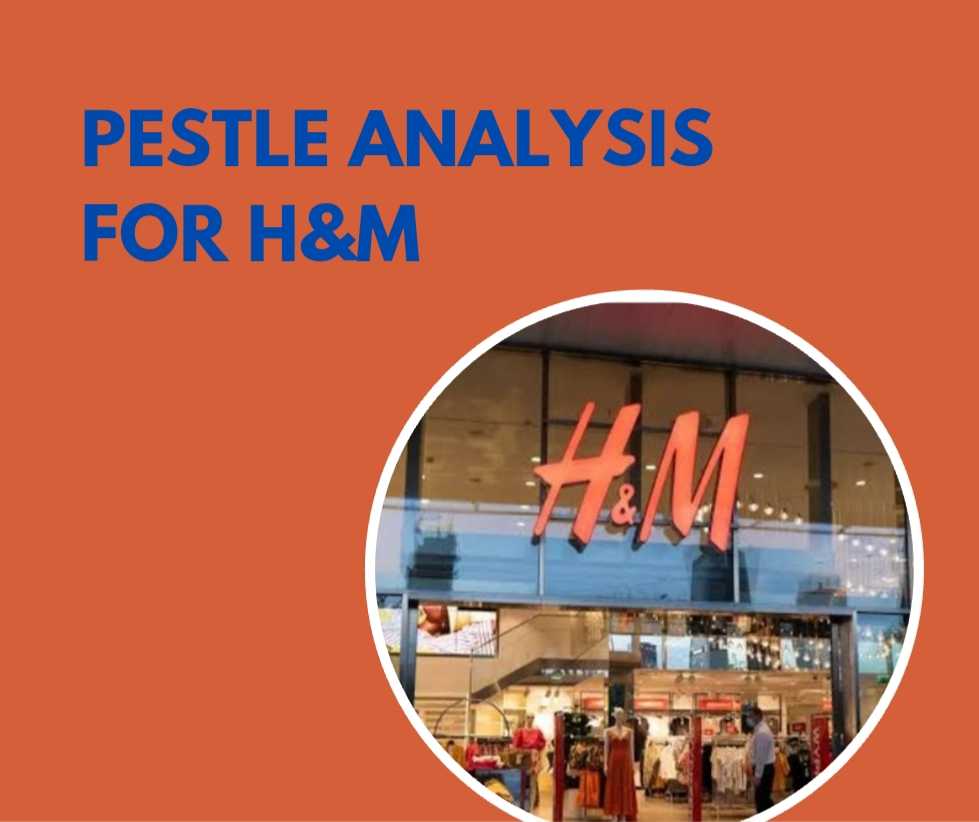H&M, a globally renowned fashion retailer, operates in a dynamic and competitive industry influenced by a multitude of external factors. Conducting a PESTLE analysis for H&M involves examining the political, economic, social, technological, legal, and environmental factors that shape its operating environment. This analytical framework helps to identify the opportunities and threats posed by these external forces, guiding strategic decision-making and adaptation to the ever-changing landscape of the fashion retail industry. By understanding these factors, H&M can proactively respond to challenges and leverage opportunities to maintain its market leadership and sustain growth in an increasingly complex global market.
Table of Contents
TogglePolitical Factors For H&M
Political factors play a significant role in shaping the business environment for H&M, influencing its operations and strategic decisions. These factors include government policies, regulations, stability, and international relations. For H&M, navigating political landscapes involves considerations such as:
- Trade Policies and Tariffs: Changes in tariffs and trade agreements between countries impact H&M’s supply chain, production costs, and pricing strategies. For instance, tariffs on imported textiles or finished goods could affect profitability.
- Labor Laws and Regulations: Compliance with labor laws in various countries where H&M operates is crucial. Regulations on working conditions, wages, and employment rights can influence production costs and operational efficiency.
- Political Stability and Risk: Operating in politically unstable regions or countries prone to civil unrest can pose risks to H&M’s supply chain, store operations, and overall business continuity.
- Taxation Policies: Tax rates, incentives, and policies related to corporate taxation affect H&M’s profitability and financial planning in different markets.
- Environmental Regulations: Policies related to environmental protection, sustainability, and carbon emissions can impact H&M’s operations, especially in terms of sourcing practices and product development.
Understanding and adapting to these political factors is essential for H&M to mitigate risks, capitalize on opportunities, and ensure compliance with regulations across its global operations.
Economic Factors For H&M
Economic factors significantly influence H&M’s business operations and strategic decisions, impacting its performance and market position globally. Key economic factors for H&M include:
- Consumer Spending Trends: Changes in consumer income levels, disposable income, and spending habits directly influence demand for fashion apparel and accessories. Economic downturns or recessions can lead to reduced consumer spending on discretionary items, affecting H&M’s sales.
- Exchange Rates: H&M operates in multiple countries and sources products globally. Fluctuations in exchange rates can impact the cost of imported goods, raw materials, and operating expenses, affecting profitability.
- Economic Growth and Stability: Overall economic growth rates and stability in key markets determine consumer confidence and purchasing power. Strong economic growth typically supports higher retail sales, while economic instability or recessionary periods may lead to reduced consumer demand.
- Inflation Rates: Changes in inflation rates affect production costs, input prices, and operating expenses for H&M. Higher inflation can increase costs of materials and transportation, potentially impacting profit margins.
- Interest Rates: Interest rate fluctuations influence borrowing costs for H&M, affecting capital expenditures, expansion plans, and financial investments. Higher interest rates can increase borrowing expenses and impact profitability.
- Unemployment Rates: Levels of unemployment impact consumer spending and confidence. High unemployment rates can reduce disposable income and discretionary spending on fashion items, affecting H&M’s sales performance.
- Global Supply Chain Dynamics: Economic factors such as transportation costs, logistics, and global trade dynamics influence H&M’s supply chain efficiency and operational costs.
Understanding these economic factors helps H&M anticipate market trends, adjust pricing strategies, manage supply chain risks, and optimize operational efficiency to maintain competitiveness in the global fashion retail industry.
Social Factors For H&M
Social factors significantly impact H&M’s business operations and strategic decisions, influencing consumer behavior, brand perception, and market trends in the fashion industry. Key social factors for H&M include:
- Fashion Trends and Consumer Preferences: Social trends and cultural shifts influence fashion preferences and purchasing decisions. H&M must stay attuned to evolving tastes, styles, and lifestyle choices to effectively cater to its diverse customer base.
- Demographic Changes: Changes in demographics, such as age, income levels, and ethnic diversity, impact H&M’s target market and product offerings. Understanding demographic trends helps H&M tailor its marketing strategies and product assortments to meet diverse consumer needs.
- Ethical and Social Responsibility: Increasing consumer awareness of ethical practices, sustainability, and social responsibility influences purchasing decisions. H&M’s commitment to sustainable fashion practices, fair labor standards, and transparent supply chain management resonates with socially conscious consumers.
- Influence of Social Media: Social media platforms play a pivotal role in shaping consumer behavior and brand perception. H&M utilizes social media channels to engage with customers, promote new collections, and leverage influencer partnerships to reach wider audiences.
- Health and Wellness Trends: Growing awareness of health and wellness impacts consumer preferences towards sustainable and organic materials in clothing. H&M’s initiatives towards offering eco-friendly and health-conscious products align with these trends.
- Cultural Diversity and Inclusivity: Embracing cultural diversity and promoting inclusivity in marketing campaigns and product offerings enhances H&M’s brand image and resonates with a global audience. Cultural sensitivity and representation are integral to maintaining a positive brand perception.
- Fashion Accessibility and Affordability: H&M’s strategy of offering fashionable and affordable clothing appeals to a broad demographic, making fashion accessible to a wide range of consumers across different social strata.
By understanding and responding to these social factors, H&M can effectively anticipate consumer preferences, strengthen brand loyalty, and maintain relevance in a rapidly evolving fashion landscape.
Technology Factors For H&M
Legal factors play a crucial role in shaping H&M’s business operations, compliance requirements, and strategic decisions within the global fashion retail industry. Key legal factors for H&M include:
- Labor Laws and Employment Regulations: Compliance with labor laws regarding working conditions, wages, and employee rights in various countries where H&M operates is essential. Adhering to regulations ensures ethical practices and mitigates risks related to labor disputes and regulatory fines.
- Consumer Protection Laws: Ensuring compliance with consumer protection laws, such as product safety regulations and advertising standards, is vital for H&M to maintain consumer trust and avoid legal liabilities.
- Intellectual Property Rights: Protecting intellectual property rights, including trademarks, copyrights, and designs, is crucial for H&M to safeguard its brand assets and prevent infringement issues.
- Data Protection and Privacy Laws: Adhering to data protection regulations, such as GDPR in Europe or CCPA in the United States, is essential when handling customer data through e-commerce platforms, loyalty programs, and marketing activities.
- Environmental Regulations: Compliance with environmental laws and regulations governing waste management, sustainability practices, and chemical usage in manufacturing processes is critical for H&M’s commitment to sustainable fashion and corporate social responsibility.
- International Trade Regulations: H&M’s global supply chain involves navigating international trade regulations, tariffs, customs duties, and trade agreements that impact sourcing strategies, import/export operations, and production costs.
- Health and Safety Regulations: Ensuring compliance with health and safety regulations in stores, warehouses, and manufacturing facilities is essential to protect employees, customers, and stakeholders.
Navigating these legal factors requires H&M to maintain robust legal and compliance departments, stay updated on regulatory changes in global markets, and integrate legal considerations into strategic planning to mitigate legal risks and ensure ethical business practices.
Envirnomental Factors For H&M
Environmental factors are increasingly critical for H&M’s business strategy, given the fashion industry’s significant impact on the environment. Key environmental factors for H&M include:
- Sustainable Sourcing and Supply Chain: H&M’s commitment to sustainable sourcing practices influences its environmental footprint. This includes using organic cotton, recycled materials, and reducing water and energy consumption in production processes.
- Climate Change and Carbon Footprint: Addressing climate change concerns involves reducing greenhouse gas emissions throughout H&M’s operations, including transportation, manufacturing, and energy usage. Setting targets for carbon neutrality and implementing renewable energy solutions are priorities.
- Waste Management and Recycling: Managing textile waste and promoting clothing recycling initiatives are crucial for H&M’s sustainability efforts. Programs such as garment collection and recycling encourage consumers to dispose of old clothes responsibly.
- Water Management: Minimizing water usage and addressing water pollution in manufacturing processes is essential. H&M works towards sustainable water management practices, including water-efficient technologies and sustainable dyeing processes.
- Biodiversity Conservation: H&M recognizes the importance of biodiversity conservation and aims to minimize its impact on ecosystems through responsible sourcing practices and habitat preservation initiatives.
- Regulatory Compliance: Adhering to environmental regulations and standards in various markets where H&M operates is critical. Compliance ensures legal compliance and demonstrates H&M’s commitment to environmental stewardship.
- Circular Economy Initiatives: Embracing circular economy principles involves designing products for longevity, promoting reuse and recycling, and minimizing waste generation throughout the product lifecycle.
By addressing these environmental factors, H&M aims to reduce its environmental footprint, meet consumer expectations for sustainable fashion, and contribute positively to environmental conservation efforts globally. Integrating environmental considerations into business operations is essential for long-term sustainability and brand reputation.







